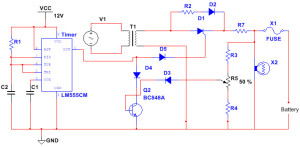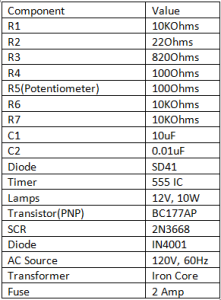DESIGN BATTERY CHARGER USING SCR and 555 TIMER
Nowadays all the electronic gadgets you use depend on the DC power supply for their operations.They usually get this power supply from the AC power supply at homes, and use a converter circuit to convert this AC to DC.
However,In case of a power failure, it is feasible to use a battery. But, the main problem with the batteries is their limited life time. Then, what should be done next? There is a way as you can use rechargeable batteries. Next, the biggest challenge is the efficient charging of the batteries.
To overcome such a challenge, a simple circuit using SCR and a 555 timer is designed to ensure controlled charging and discharging of the battery with indication.
Circuit Components
Circuit Connection
A 230V power is supplied to the primary of the transformer. The secondary of the transformer is connected to the cathode of the Silicon Control Rectifier (SCR). Next, the anode of the SCR is connected to a lamp, and then, a battery is connected in parallel. A combination of two resistors (R5 and R4) is then connected in series with a 100Ohm potentiometer across the battery. A 555 timer in a mono-stable mode is used,and it gets triggered from a series combination of a diode and a PNP transistor.
Circuit Diagram

Circuit Operation
The step-down transformer reduces the AC voltage at its primary, and this reduced AC voltage is given at its secondary. The SCR used here acts as a rectifier. In normal operation, when the SCR is conducting, it allows the DC current to flow to the battery. Whenever the battery is charged, a small amount of current flows through the potential divider arrangement of R4, R5, and the potentiometer.
As the diode receives very small amount of current, it conducts insignificantly.When this small amount of biasing is applied to the PNP transistor, it conducts. As a result, the transistor is connected to the ground, and the input pin of the timer is given a low logic signal, which triggers the timer. The output of the timer is then given to the Gate terminal of the SCR,which is triggered to conduction.
If the battery is fully charged, it starts discharging and the current through the potential divider arrangement increases, and the diode also starts conducting heavily, and then the transistor is in cut off region. This fails to trigger the timer, and as a result, the SCR is not triggered and this stops the current supply to the battery. As the battery charges, an indication is given by a lamp which glows.
This is all about a few simple electronic project ideas for all those individuals who are interested in building their own electronic projects. We hope this type of projects and project ideas will be helpful to the students, and therefore, if anyone of the project catches your attention or to know how to step up the DC voltage using 555 timer, which is enough to implement it, do give your comments, feedback and suggestions to us,and also write to us about the kind of changes you can bring in to those projects using your own ideas.

Comments
Post a Comment